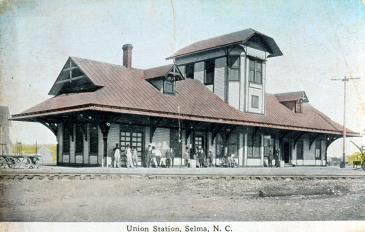
How the railroad inspired our towns
In the antebellum times of the 1840's, the most vociferous advocates of inland waterway transportation were reluctant to yield their enthusiasm to the burgeoning railroad industry, but popular interest in rails overshadowed interest in river transportation during the two decades immediately preceding the Civil War. The first railroad built across Johnston County - the 223-mile state-controlled North Carolina Railroad from Goldsboro to Charlotte (via Raleigh and Greensboro) was completed in 1856. It bypassed Smithfield some four miles to the north, following a beeline between Goldsboro and Raleigh. Smithfield passengers boarded the train at a station originally called "Smithfield Depot," located just west of what is now Selma, where Buffalo Road crosses the present-day Southern Railway. The depot later became known as "Mitchener's Station."

Smithfield travelers and merchants were hardly pleased by the location of the North Carolina Railroad, since Smithfield Depot was almost an hour's drive from the heart of Smithfield by wagon or hack. Tradition, still persistent in the latter half of the twentieth century, has asserted that Smithfield residents opposed locating the railroad through the town, that they did not want noisy trains disturbing their peace nor steam engines polluting their clean air with smoke. Succeeding generations have been told that a "Smithfield man" voted against locating the railroad through Smithfield, and that the town lost the railroad "by one vote." Two Johnston County members of the Legislature did vote against the legislation that incorporated the North Carolina Railroad in 1849, and a single vote ultimately decided whether the railroad was to be approved. But legislative records do not support the legend preserved by spoken words.
Representative Andrew J. Leach of Johnston voted against the railroad bill on all readings, and Johnston's Senator William H. Watson voted against it on the final reading. Apparently both legislators voted as they did because they lacked assurance that the surveyors would lay out the railroad's route through or at the edge of Smithfield's corporate limits. Senator Watson, who supported the bill on first and second reading, offered an amendment requiring the railroad to serve Smithfield directly and not bypass it some miles away. When the amendment was rejected, he withdrew his support of the railroad charter. His shift to the opposition deadlocked the Senate, and the presiding officer was compelled to break the tie. He voted "aye."
The coming of the North Carolina Railroad to Johnston County was the impetus that (after 1860) gave rise to the towns of Princeton (originally chartered as Boon Hill), Pine Level, Selma, Wilson's Mills and Clayton (earlier Stallings Station), just as a north-south railroad, the Wilmington and Weldon Railroad forerunner of the Atlantic Coast Line in the late 1880's would bring into being the towns of Kenly, Micro, Four Oaks and Benson.
Although the North Carolina Railroad was not completed all the way between Goldsboro and Charlotte until 1856 when opposite ends of the line were joined near Greensboro, service began shortly after rails were laid across the county in 1854. The coming of railroads would make a difference in the economic and geographical complexion of the county. They also would open the outside world to residents of Smithfield and the rest of the county who had not been able to afford travel by stagecoach. Before railroad service came to Johnston, one-way travel by stage from Goldsboro to Charlotte cost $23 (more than the monthly income of a school teacher in the 1850's). The original train fare from Goldsboro to Charlotte, one way, was only $5.
(Taken from "A Short History of Johnston County: 1746-1890," by Thomas J. Lassiter. "The Heritage of Johnston County North Carolina," Volume I, 1984.)





